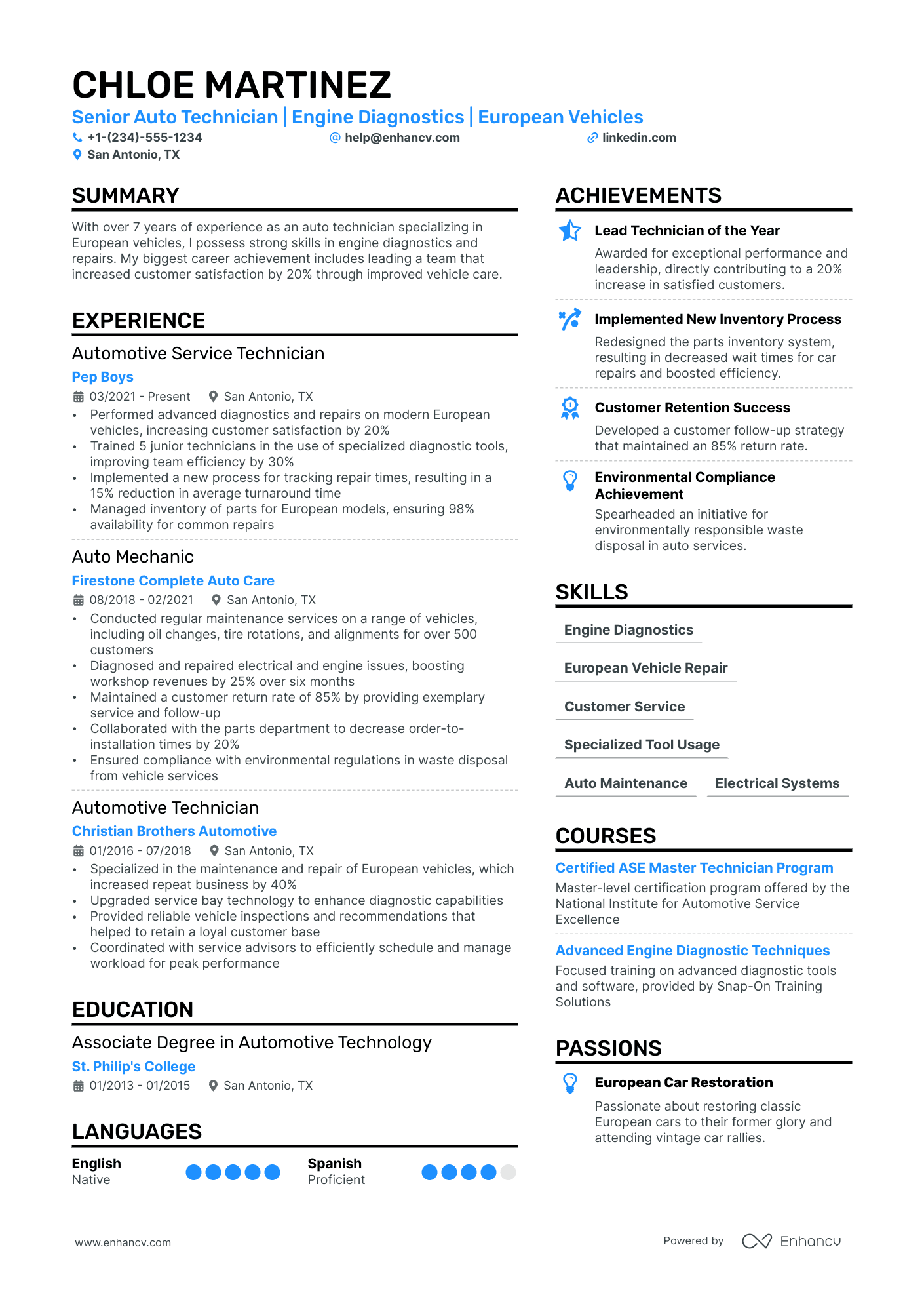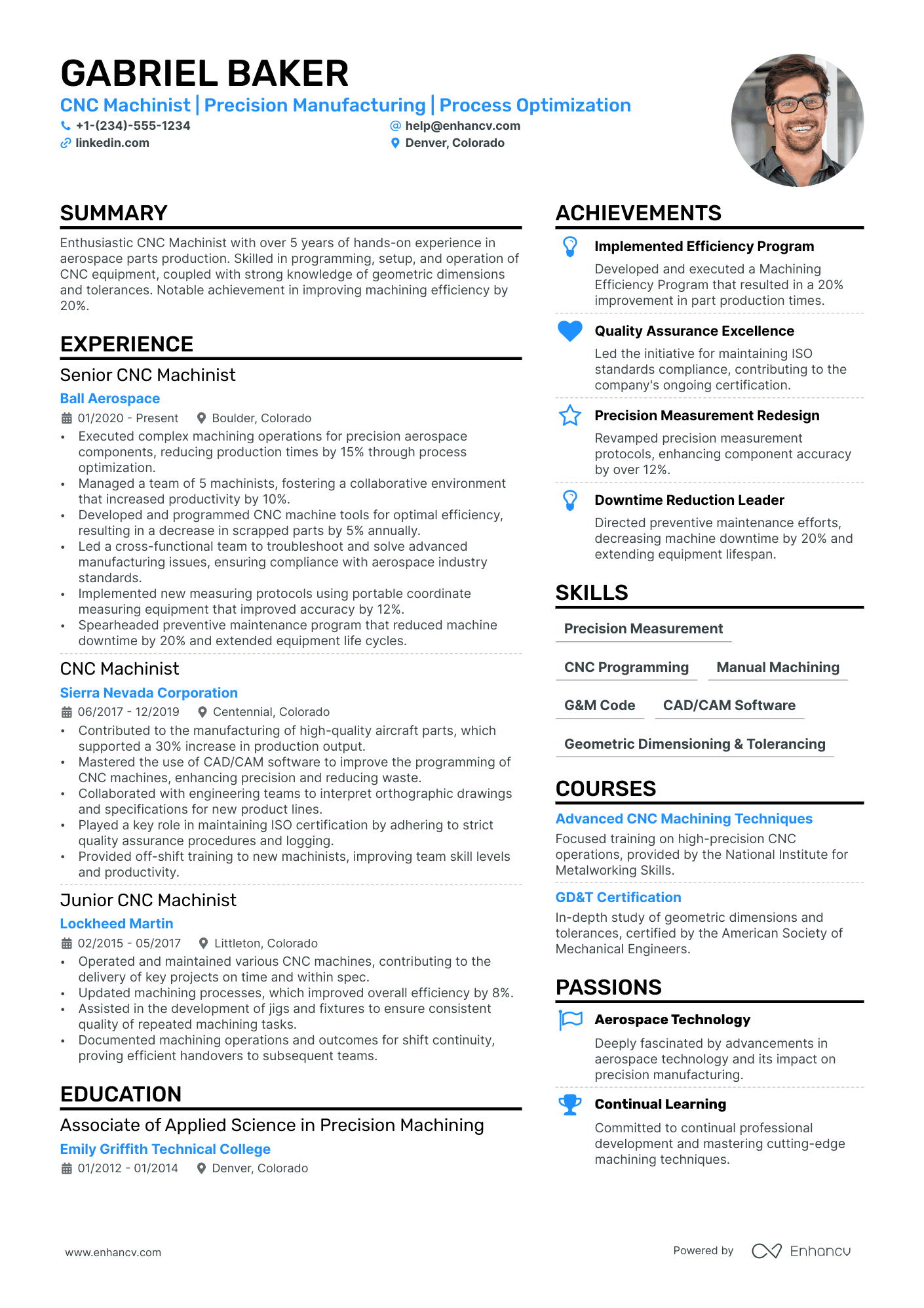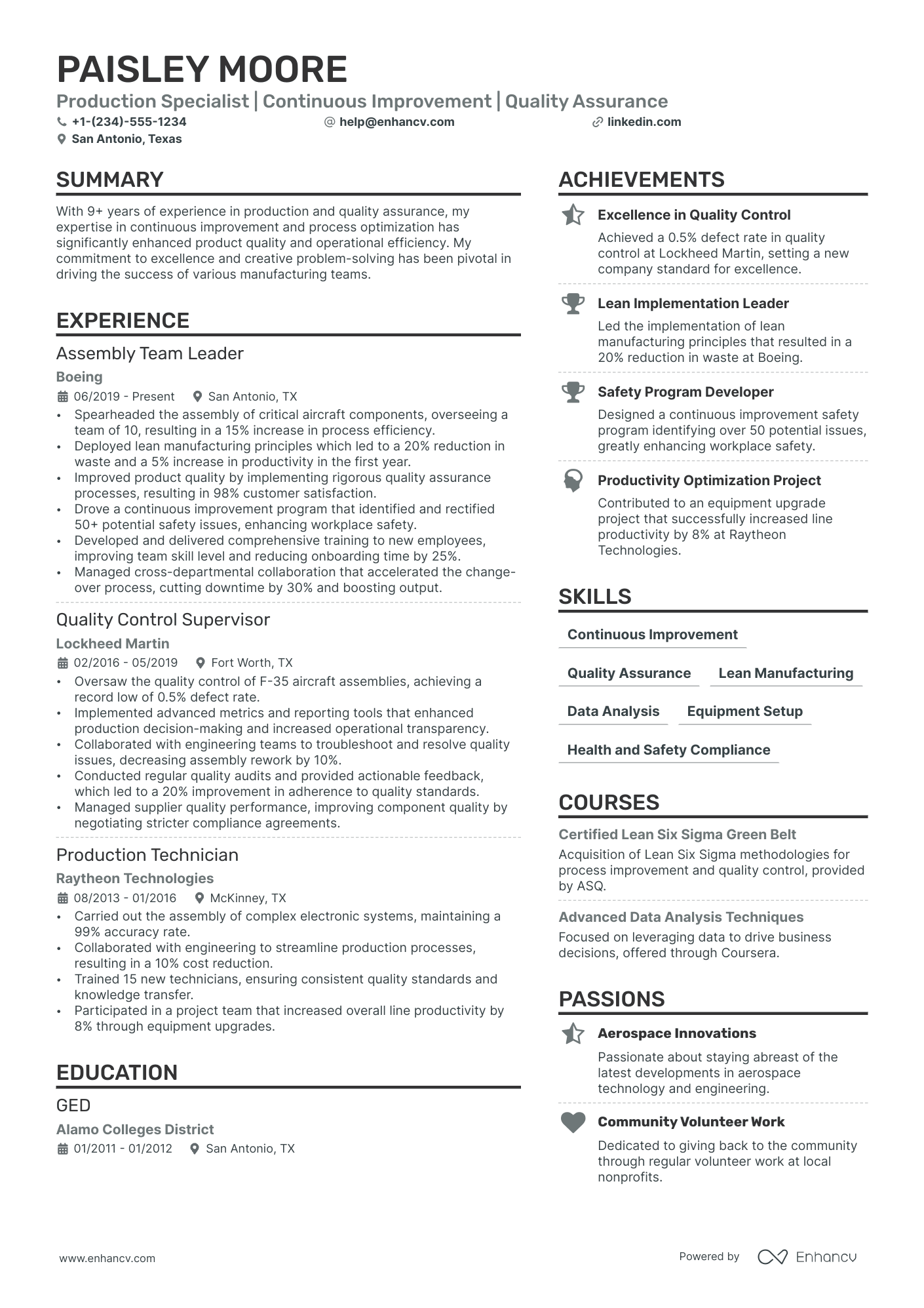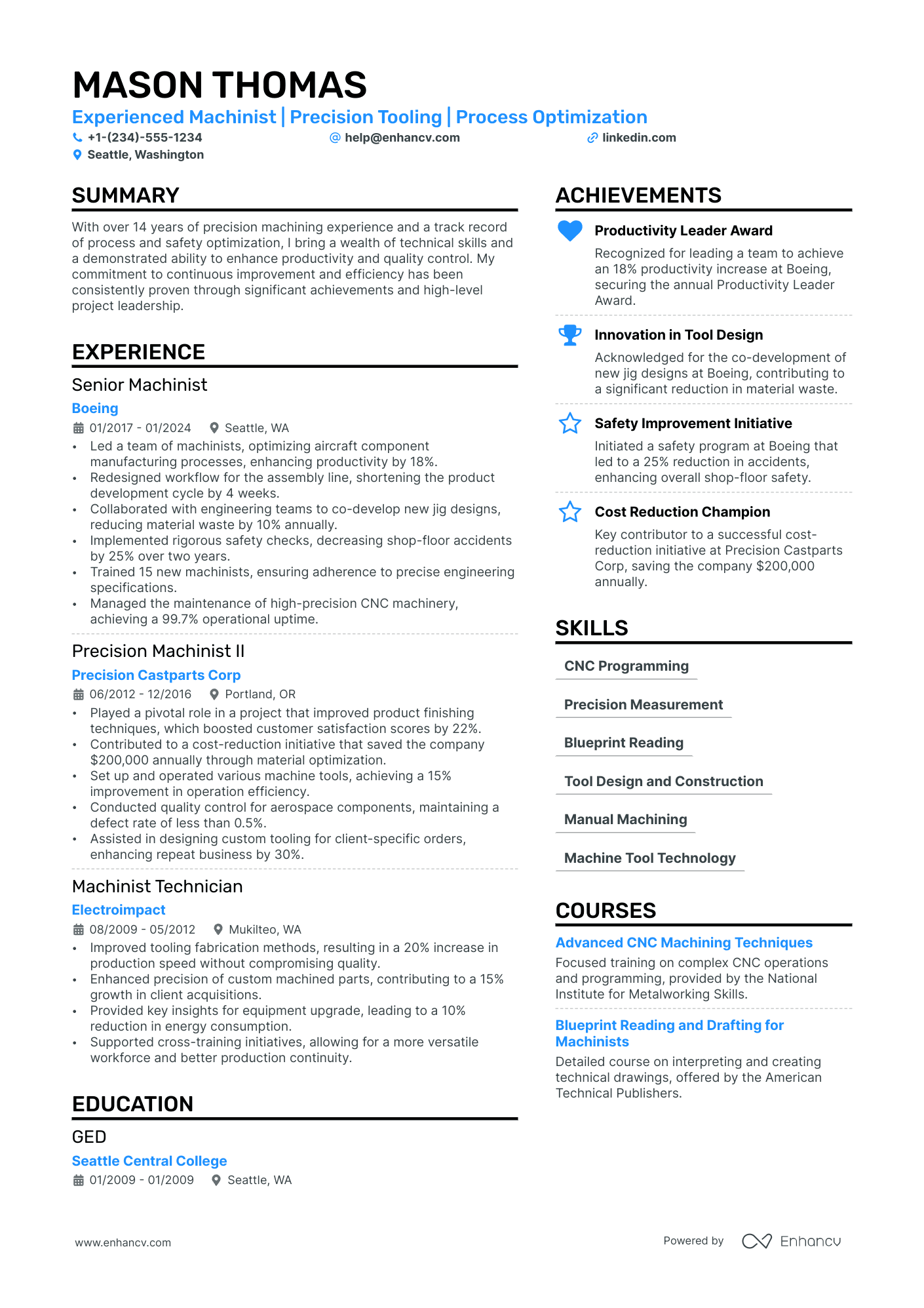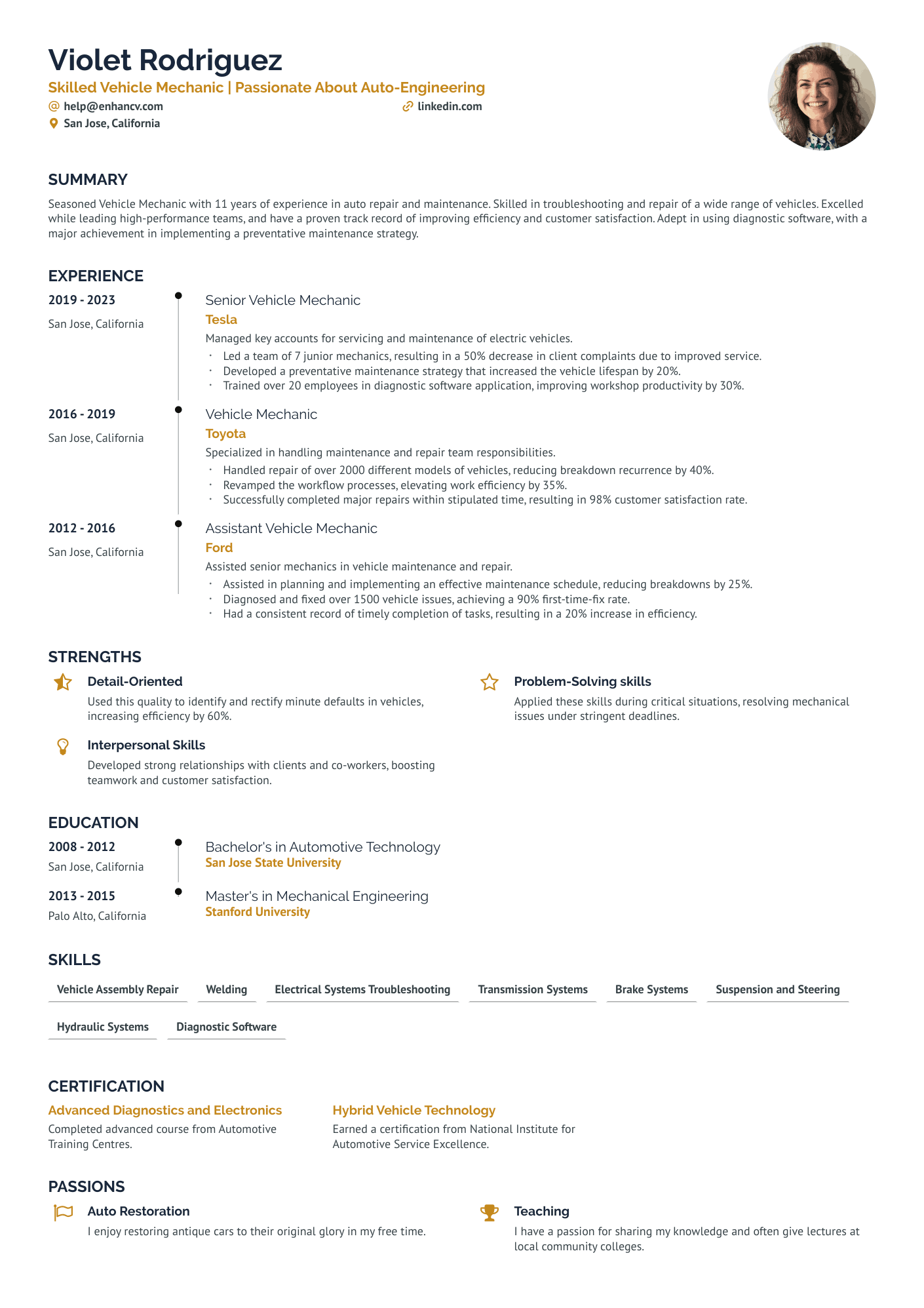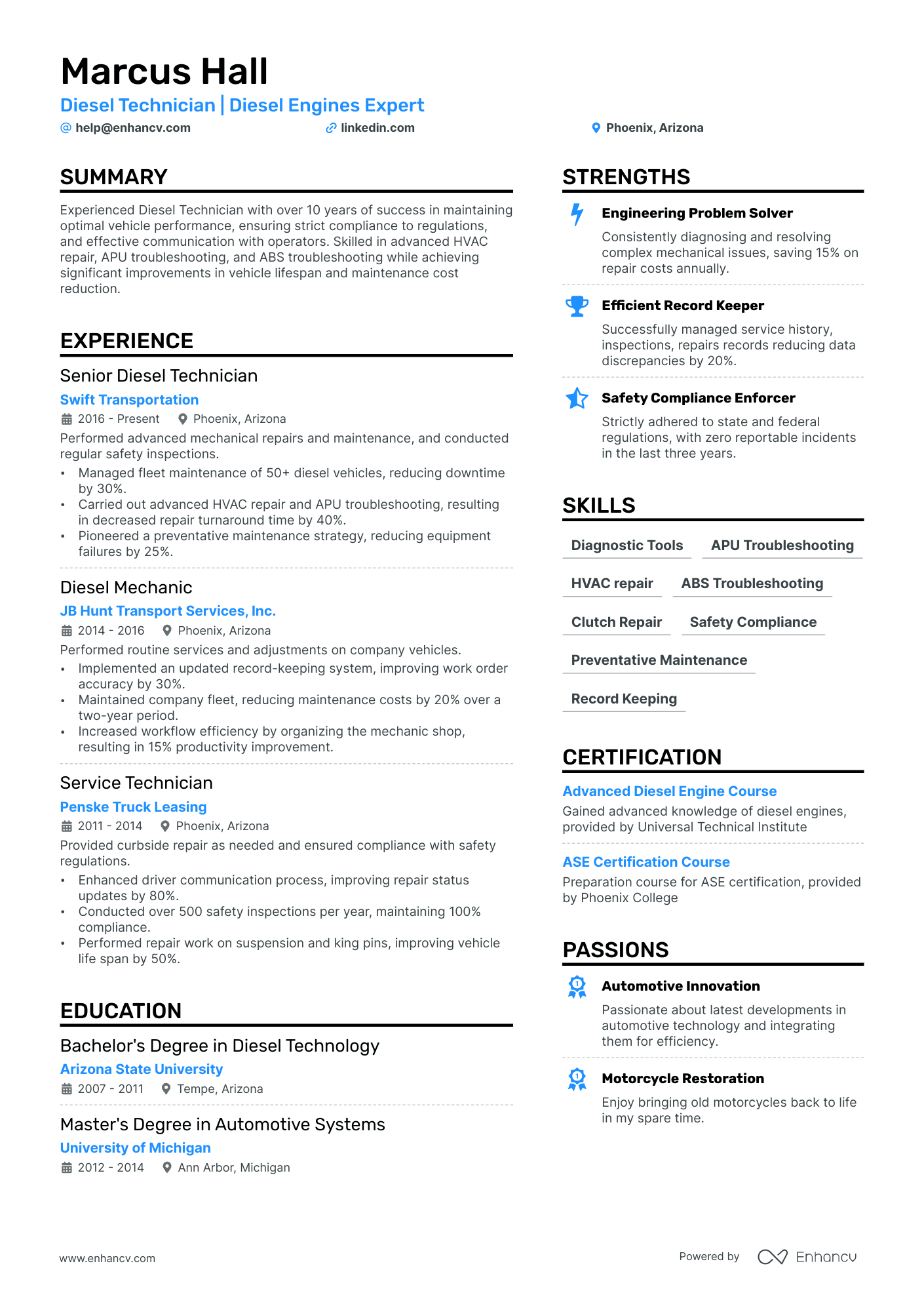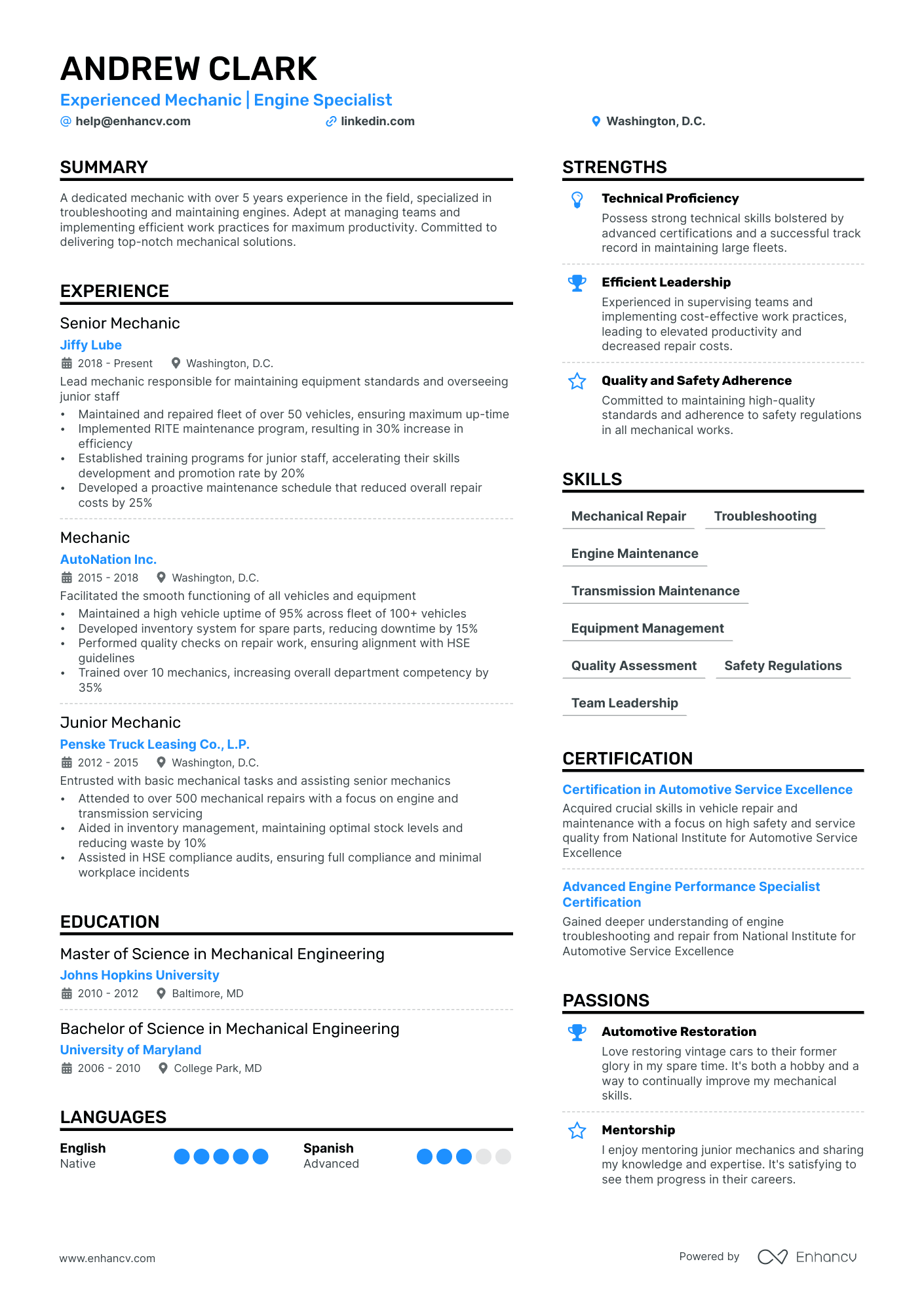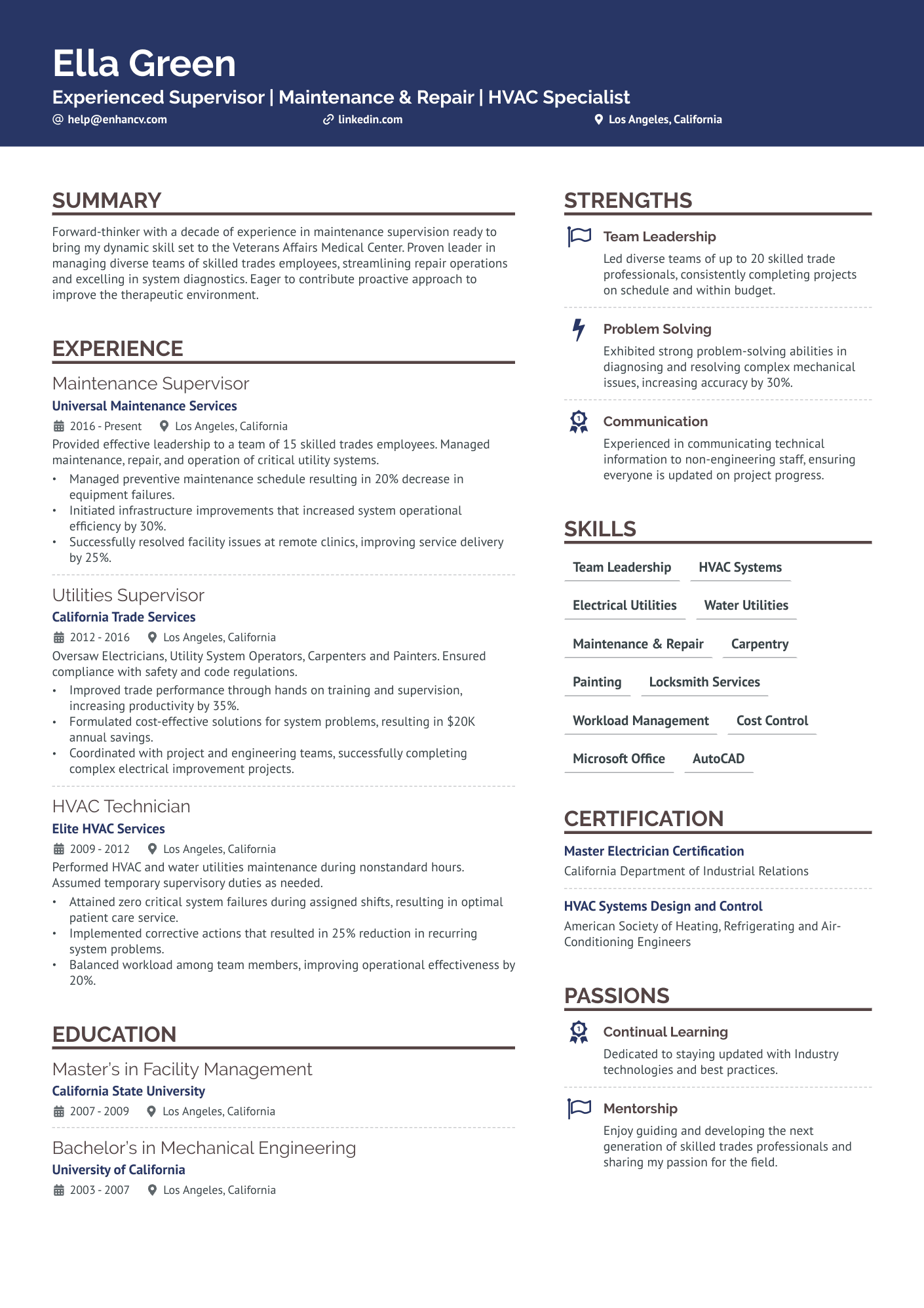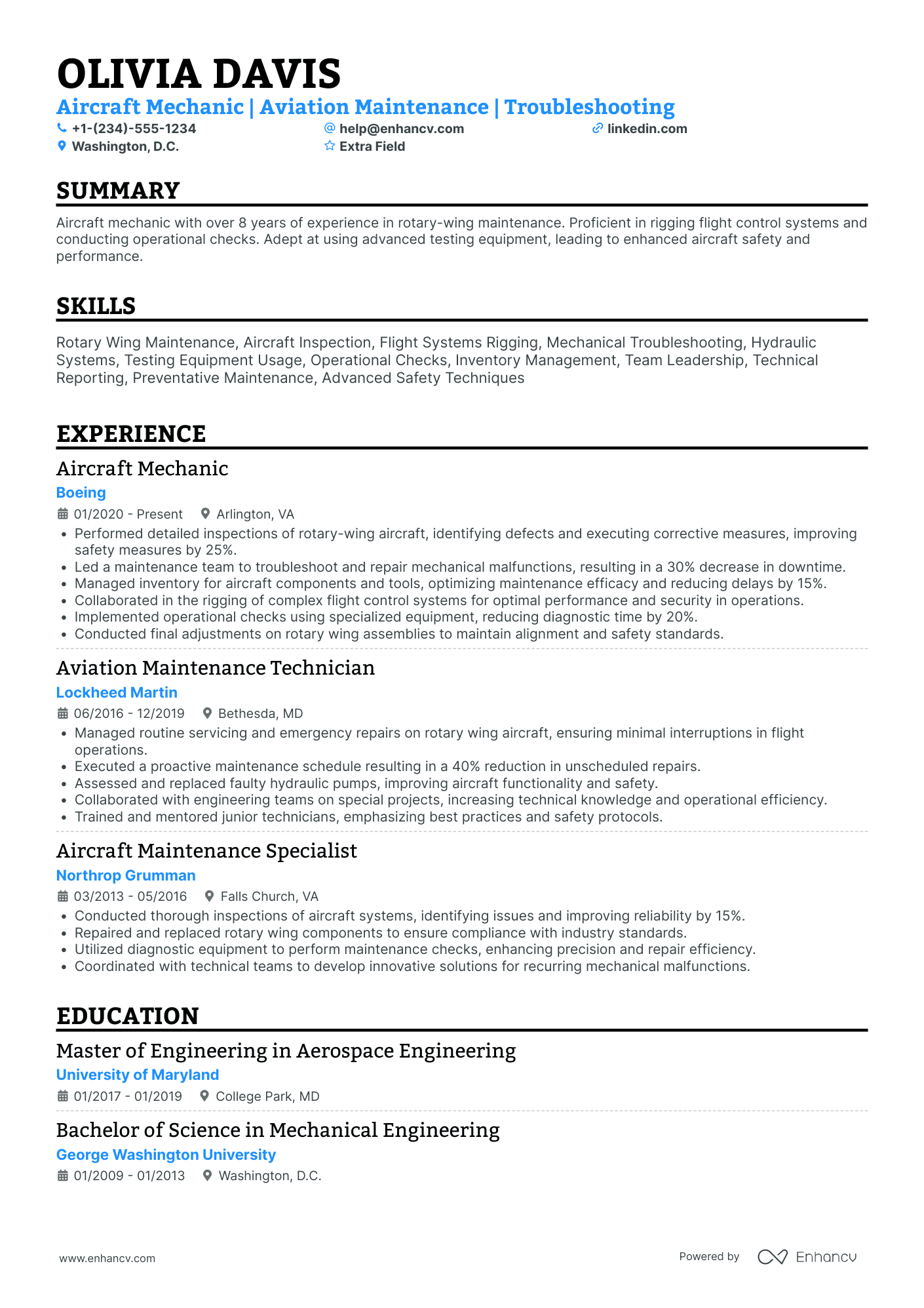As a mechanic, one specific resume challenge you may face is effectively translating your hands-on technical skills and diverse work experience into language that resonates with non-technical hiring managers. Our guide can help you by providing tailored advice on structuring your resume and selecting the right terminology to highlight your capabilities, making you a standout candidate to employers across industries.
- Mechanic resumes that are tailored to the role are more likely to catch recruiters' attention.
- Most sought-out mechanic skills that should make your resume.
- Styling the layout of your professional resume: take a page from mechanic resume examples.
How to write about your mechanic achievements in various resume sections (e.g. summary, experience, and education).
- Regional Property Manager Resume Example
- Pest Control Resume Example
- Housekeeping Manager Resume Example
- Housekeeper Resume Example
- Maintenance Technician Resume Example
- Landscaping Resume Example
- Maintenance Manager Resume Example
- Cleaning Manager Resume Example
- Cable Technician Resume Example
- Resident Assistant Resume Example
Formatting the Layout of Your Mechanic Resume: Design, Length, and More
When it comes to the format of your mechanic resume , you've plenty of opportunities to get creative. But, as a general rule of thumb, there are four simple steps you could integrate into your resume layout.
- If you have plenty of experience, you'd like to showcase, invest in the reverse-chronological resume format . This format focuses on your latest experience items and skills you've learned during your relevant (and recent) jobs.
- Don't go over the two-page limit, when creating your professional mechanic resume. Curate within it mainly experience and skills that are relevant to the job.
- Make sure your mechanic resume header includes all of your valid contact information. You could also opt to display your professional portfolio or LinkedIn profile.
- Submit or send out your mechanic resume as a PDF, so you won't lose its layout and design.
Different regions expect different formats – Canadian resumes, for example, may look unique.
Upload & Check Your Resume
Drop your resume here or choose a file. PDF & DOCX only. Max 2MB file size.
PRO TIP
If you happen to have some basic certificates, don't invest too much of your mechanic resume real estate in them. Instead, list them within the skills section or as part of your relevant experience. This way you'd ensure you meet all job requirements while dedicating your certificates to only the most in-demand certification across the industry.
The six in-demand sections for your mechanic resume:
- Top one-third should be filled with a header, listing your contact details, and with a summary or objective, briefly highlighting your professional accolades
- Experience section, detailing how particular jobs have helped your professional growth
- Notable achievements that tie in your hard or soft skills with tangible outcomes
- Popular industry certificates to further highlight your technical knowledge or people capabilities
- Education to showcase your academic background in the field
What recruiters want to see on your resume:
- Hands-on experience with various diagnostic equipment and tools specific to auto repair and maintenance.
- Detailed knowledge of mechanical and electronic systems in vehicles, such as engines, transmission systems, and braking systems.
- Certifications relevant to automotive repair, such as ASE (Automotive Service Excellence) certification.
- A history of successfully diagnosing and repairing mechanical issues efficiently to reduce customer wait times.
- Strong understanding of safety protocols and procedures in a garage or repair shop environment.
Creating Your Mechanic Resume Experience to Catch Recruiters' Attention
Remember that for the mechanic role, hiring managers are looking to see how your expertise aligns with their requirements. Here's where your resume experience section can help out. Make sure you:
- Include mainly roles that are relevant to the mechanic job you're applying for;
- Don't go too far back in your experience - recruiters will only care what you did a decade ago if it's really important for the mechanic role;
- Each bullet you include should say what you did, followed by the skills you used and the actual end result of your efforts;
- Quantify each of your achievements with numbers and possibly the overall effect it had on the organization;
- Highlight transferrable skills - or personal skills you've attained thanks to past jobs - that could be applicable within your potential workplace. This would showcase your unique value as a professional.
Formatting the experience section of your resume doesn't have to be an over-the-top deep dive into your whole career. Follow the mechanic resume examples below to see how industry-leading professionals are presenting their experience:
- Diagnosed and repaired over 250 diesel engines, leading to a 15% increase in workshop efficiency for the fleet of delivery trucks.
- Implemented a new inventory management system for replacement parts, reducing downtime by 25% due to better parts availability.
- Mentored and trained 5 junior mechanics, increasing the team's overall skill level and decreasing reliance on external consultants.
- Led a team in retrofitting an entire fleet of 30 company vehicles with new emission control systems to comply with updated EPA standards.
- Developed and implemented a preventive maintenance program that reduced breakdowns by 40% over a 2-year period.
- Managed the successful overhaul of transmission systems for heavy-duty equipment, extending the lifecycle of machinery by an average of 3 years.
- Conducted detailed analysis and repair of hydraulic systems in construction machinery, documenting procedures that improved repair times by 20%.
- Collaborated with engineers on upgrading the heating and cooling systems in mobile machinery, which resulted in a 10% reduction in fuel consumption.
- Spearheaded the ordering process for specialized tools, reducing equipment costs by negotiating with suppliers for a 15% discount.
- Orchestrated the refurbishment of classic cars, including engine rebuilds and electrical overhauls, for a portfolio of 20+ high-end clients.
- Customized and tuned performance vehicles, achieving an average of 35% increase in horsepower for client projects.
- Mastered the use of diagnostic software for luxury car brands, which enhanced diagnostic accuracy and client satisfaction.
- Introduced a computerized diagnostic approach for vehicle troubleshooting, reducing diagnostic time by an average of 30% per vehicle.
- Managed and completed the end-to-end engine replacement for over 50 vehicles, ensuring adherence to factory standards.
- Coordinated with the customer service department to improve communication regarding repairs, leading to a 20% improvement in customer satisfaction scores.
- Spearheaded the integration of hybrid technology into company's vehicle line-up, contributing to a 30% increase in hybrid vehicle sales.
- Trained over 25 staff on electric vehicle repair techniques, fostering an environment of continuous learning and adaptation to new technologies.
- Managed the rollout of a new electronic vehicle inspection system, which improved the reliability of pre-sale vehicle assessments.
- Revamped the workshop floor layout to streamline the repair process, which slashed turnaround times by 35% for major repairs.
- Played a key role in the transition to a fully paperless job tracking system, enhancing operational efficiency and reducing errors by 50%.
- Led a 6-month initiative to train staff on advanced drivetrain systems, ensuring the company maintained a competitive edge in the market.
- Optimized workflow through strategic planning, which resulted in achieving a 99% on-time completion rate for scheduled maintenance.
- Instrumental in establishing a new service center that increased the company's service capacity by 40% within its first year.
- Implemented a comprehensive safety protocol for equipment handling, reducing workplace accidents by 60% within a two-year period.
The following content includes information from "O*NET OnLine" by the U.S. Department of Labor, Employment and Training Administration (USDOL/ETA). Used under the CC BY 4.0 license. The data represents the top responsibilities present on the task lists for mechanic professionals.
Top Responsibilities for Mechanic:
- Reassemble machines after making repairs or replacing parts.
- Converse with customers to determine details of equipment problems.
- Disassemble machines to examine parts, such as wires, gears, or bearings for wear or defects, using hand or power tools and measuring devices.
- Advise customers concerning equipment operation, maintenance, or programming.
- Align, adjust, or calibrate equipment according to specifications.
- Repair, adjust, or replace electrical or mechanical components or parts, using hand tools, power tools, or soldering or welding equipment.
- Travel to customers' stores or offices to service machines or to provide emergency repair service.
- Maintain parts inventories and order any additional parts needed for repairs.
- Operate machines to test functioning of parts or mechanisms.
- Reinstall software programs or adjust settings on existing software to fix machine malfunctions.
Quantifying impact on your resume
- Document the number of routine maintenance tasks completed daily to demonstrate efficiency and work ethic.
- Highlight the percentage of first-time fixes on vehicles to emphasize diagnostic accuracy and skill.
- Quantify the amount of time saved by implementing new procedures or using innovative tools to show problem-solving abilities.
- State the number of years you have experience with specific makes or models to showcase specialized knowledge.
- Include the volume of customers you have managed or advised to reflect customer service skills.
- Specify inventory management expertise by detailing the value or variety of parts managed to demonstrate organizational skills.
- Measure the reduction in machine downtimes achieved through your preventive maintenance to highlight reliability and foresight.
- List any relevant courses by the number of hours or credits completed to show your commitment to ongoing education and skills development.
Action verbs for your mechanic resume
Four quick steps for candidates with no resume experience
Those with less or no relevant experience could also make a good impression on recruiters by:
- Taking the time to actually understand what matters most to the role and featuring this within key sections of their resume
- Investing resume space into defining what makes them a valuable candidate with transferrable skills and personality
- Using the resume objective to showcase their personal vision for growth within the company
- Heavily featuring their technical alignment with relevant certifications, education, and skills.
Remember that your resume is about aligning your profile to that of the ideal candidate.
The more prominently you can demonstrate how you answer job requirements, the more likely you'd be called in for an interview.
Recommended reads:
PRO TIP
Listing your relevant degrees or certificates on your mechanic resume is a win-win situation. Not only does it hint at your technical capabilities in the industry, but an array of soft skills, like perseverance, adaptability, and motivation.
Key Hard Skills and Soft Skills for Your Mechanic Resume
At the top of any recruiter mechanic checklist, you'd discover a list of technical competencies, balanced with personal skills.
Hard or technical skills are your opportunity to show how you meet the essential responsibilities of the role. The ability to use a particular job-crucial technology or software would also hint to recruiters whether you'd need a prolonged period of on-the-job training - or you'd fit right in the job.
But to land your dream role, you'd also need to demonstrate a variety of soft or people resume skills . Employers care about soft skills as they show how each candidate would fit into the team and company culture.
Both types of skills are specific and to best curate them on your resume, you'd need to:
- Create a skill section within which you showcase your hard and soft skills and present how they help you succeed.
- List specific examples of projects, tasks, or competitions, within which your skill set has assisted your results.
- Soft skills are harder to measure, so think about situations in which they've helped you thrive. Describe those situations concisely, focusing on how the outcome has helped you grow as a professional.
- Metrics of success - like positive ROI or optimized workplace processes - are the best way to prove your technical and people skills.
Take a look at some of mechanic industry leaders' favorite hard skills and soft skills, as listed on their resumes.
Top skills for your mechanic resume:
Automotive repair
Engine diagnostics
Brake systems
Electrical systems
Transmission repair
Suspension systems
Welding and fabrication
Hydraulic systems
Diagnostic tools (OBD-II, multimeter)
Preventive maintenance
Problem-solving
Attention to detail
Communication
Time management
Teamwork
Customer service
Adaptability
Critical thinking
Analytical skills
Work ethic
Next, you will find information on the top technologies for mechanic professonals from "O*NET OnLine" by the U.S. Department of Labor, Employment and Training Administration (USDOL/ETA). Used under the CC BY 4.0 license.
Top technologies for Mechanic’s resume:
- Email software
- Microsoft Outlook
- Microsoft PowerPoint
- Linux
- UNIX
PRO TIP
Showcase any ongoing or recent educational efforts to stay updated in your field.
How to Include Your Education and Certifications on Your Resume
We're taking you back to your college days with this part of our guide, but including your relevant higher education is quite important for your resume.
Your degree shows recruiters your dedication to the industry, your recent and relevant know-how, and some form of experience in the field.
Your mechanic resume education should:
- Include your applicable degrees, college (-s) you've graduated from, as well as start and end dates of your higher education;
- Skip your high school diploma. If you still haven't graduated with your degree, list that your higher education isongoing;
- Feature any postgraduate diplomas in your resume header or summary - this is the perfect space to spotlight your relevant MBA degree;
- Showcase any relevant coursework, if you happen to have less professional experience and think this would support your case in being the best candidate for the role.
As far as your job-specific certificates are concerned - choose up to several of the most recent ones that match the job profile, and include them in a dedicated section.
We've saved you some time by selecting the most prominent industry certificates below.
The top 5 certifications for your mechanic resume:
- Automotive Service Excellence (ASE) - National Institute for Automotive Service Excellence
- Certified Master Medium/Heavy Truck Technician (Master Truck) - National Institute for Automotive Service Excellence
- Certified Master Automobile Technician (Master Auto) - National Institute for Automotive Service Excellence
- Automotive Management Institute (AMI) Accredited Automotive Manager (AAM) - Automotive Management Institute
- Advanced Engine Performance Specialist Certification (L1) - National Institute for Automotive Service Excellence
The content below includes information from "O*NET OnLine" by the U.S. Department of Labor, Employment and Training Administration (USDOL/ETA). Used under the CC BY 4.0 license. The data represents the top associations for mechanic professionals.
Top US associations for a Mechanic professional
- CompTIA
- Electronics Technicians Association International
- International Society of Certified Electronics Technicians
PRO TIP
If the certificate you've obtained is especially vital for the industry or company, include it as part of your name within the resume headline.
Recommended reads:
The Summary Or Objective: Focusing on the Top One-third of Your Resume
It's a well-known fact that the top one-third of your mechanic resume is the make-it-or-break-it moment of your application. The resume summary and objective could help you further build up your professional profile.
- If you have plenty of career highlights behind your back, use the resume summary . The mechanic summary immediately focuses recruiters' attention on what matters most within your experience.
- The resume objective is the perfect choice for balancing your career achievements with your vision. Use it to state precisely how you see yourself in a couple of years' time - as part of the company you're applying for.
Both the resume summary and resume objective can be your value pitch to potential employers: answering what makes your application unique and the top choice for the mechanic role. They both have to be specific and tailored - as there's no one-size-fits-all approach to writing your mechanic summary or objective. Use the mechanic examples below as a starting point:
Resume summaries for a mechanic job
- Seasoned automotive mechanic with over 15 years of hands-on experience in a high-volume dealership setting, with mastery in diagnostic tools and ASE certifications. Expert in European luxury vehicles with a record of increasing customer satisfaction score by 25% through meticulous attention to detail and swift issue resolution.
- Dynamic individual transitioning from a 10-year career in industrial equipment repair to automotive mechanics, seeking to apply extensive knowledge of hydraulic systems and electrical diagnostics to a new challenge. Proven success in reducing machinery downtime by 30% at BlueWave Manufacturing by implementing proactive maintenance schedules.
- Multifaceted ex-aerospace technician with a robust understanding of propulsion systems and 8 years of experience, pivoting towards automotive repair to bring a unique perspective in high-performance engine tuning and maintenance. Awarded 'Top Technician' for outstanding problem-solving abilities at SkyHigh Engines Inc.
- Aspiring mechanic, eager to leverage a lifelong passion for automotive restoration and recently completed professional certification at TechPro Automotive Institute. Adept in basic engine diagnostics and repair, with a commitment to obtaining ASE certification, and a strong desire to learn under experienced mentors in a progressive auto repair environment.
- Freshly graduated from the National mechanics Academy, a disciplined and enthusiastic beginner with a toolkit of basic diagnostic skills, a fundamental understanding of modern vehicle systems, and an objective to grow expertise in the detail-oriented field of classic car restoration and customization.
Average Salary Info by State in the US for Mechanic Professionals
Local salary info for Mechanic.” Source: My Next Move, National Center for O*NET Development. Accessed 10/15/2024
| State | Average Salary (in USD) |
|---|---|
| US National Average | $45,760 |
| California (CA) | $49,680 |
| Texas (TX) | $39,230 |
| Florida (FL) | $41,000 |
| New York (NY) | $57,670 |
| Pennsylvania (PA) | $40,890 |
| Illinois (IL) | $43,480 |
| Ohio (OH) | $44,360 |
| Georgia (GA) | $42,640 |
| North Carolina (NC) | $47,730 |
| Michigan (MI) | $39,440 |
More Relevant Sections for Your Mechanic Resume
Perhaps you feel that your current resume could make use of a few more details that could put your expertise and personality in the spotlight.
We recommend you add some of these sections for a memorable first impression on recruiters:
- Projects - you could also feature noteworthy ones you've done in your free time;
- Awards - showcasing the impact and recognition your work has across the industry;
- Volunteering - the social causes you care the most about and the soft skills they've helped you sustain and grow;
- Personality resume section - hobbies, interests, favorite quote/books, etc. could help recruiters gain an even better understanding of who you are.
Key Takeaways
- Pay special attention to the tiny details that make up your mechanic resume formatting: the more tailored your application to the role is, the better your chances at success would be;
- Select the sections you include (summary or objective, etc.) and formatting (reverse-chronological, hybrid, etc.) based on your experience level;
- Select experience items and, consequently, achievements that showcase you in the best light and are relevant to the job;
- Your profile will be assessed both based on your technical capabilities and personality skills - curate those through your resume;
- Certifications and education showcase your dedication to the particular industry.
Mechanic resume examples
Explore additional mechanic resume samples and guides and see what works for your level of experience or role.
By Role
